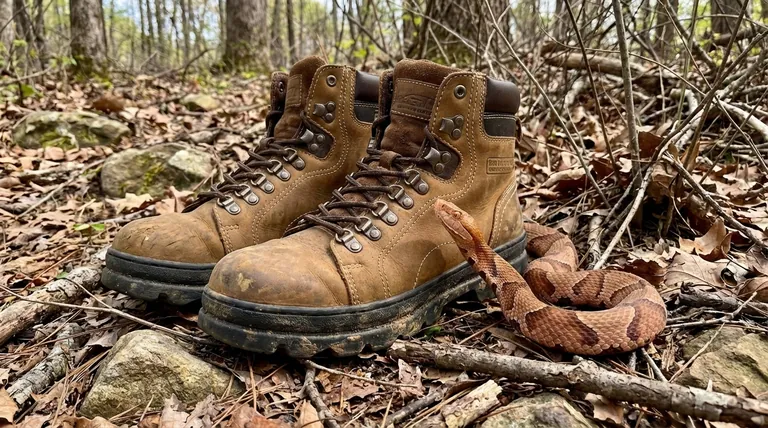Yes, it is possible for a copperhead to bite through a boot. However, the outcome is not guaranteed and depends almost entirely on the boot's specific materials, thickness, and construction. While a sturdy leather or rubber boot offers significantly more protection than a sneaker, it is not a substitute for footwear specifically engineered and rated for snakebite protection.
The core issue is not a snake's power but a boot's design. Standard work and hiking boots provide incidental, unreliable protection, whereas certified snake-proof boots are specifically engineered to stop fang penetration.

What Determines a Boot's Resistance?
Understanding why some boots fail while others succeed requires looking at a few key engineering and material factors. A snakebite is a puncture event, and a boot's ability to resist it comes down to physics.
The Critical Role of Material Thickness and Stiffness
A snake's fangs are sharp but relatively delicate. They are designed to penetrate skin and muscle, not rigid materials.
Thick, stiff leather or dense rubber is difficult for fangs to pierce. The material either deflects the fang or is too thick for the fang to penetrate through to the skin.
Boot Height and Coverage
Most venomous snakebites in the U.S. occur on the feet, ankles, and lower legs. This makes boot height a critical factor in protection.
A low-cut hiking shoe leaves the entire ankle exposed. A standard 6-inch or 8-inch work boot offers better coverage, but a snake-proof boot often extends 16 to 18 inches, protecting the leg almost to the knee.
The Snake's Size and Strike
Not all strikes are equal. A larger, mature copperhead will have longer fangs and can strike with more force than a juvenile.
The angle of the bite also matters. A direct, perpendicular strike has a much higher chance of penetration than a glancing blow off the side of a rounded boot.
The Trade-offs: Standard Boots vs. Snake Boots
Many people assume their rugged work boots or cowboy boots are sufficient. While better than nothing, this assumption can be dangerous because it confuses incidental protection with intentional design.
The Limits of Standard Leather Boots
Most leather work, hiking, or cowboy boots are designed to protect against abrasion, impact, and water—not high-velocity punctures.
Their protective capability against a snake is a byproduct of their sturdy construction, not a tested feature. The leather's thickness and quality can vary widely, making their effectiveness unpredictable.
The Engineering of Snake-Proof Boots
Certified snake-proof boots are purpose-built. They often use a multi-layer system combining an outer layer of leather or cordura with inner layers of puncture-resistant materials like woven synthetics or neoprene.
These boots are tested against real-world scenarios to ensure they can stop a snake's fangs, providing a reliable and verifiable level of safety.
The Cost in Comfort and Weight
This dedicated protection comes with trade-offs. Snake boots are typically heavier, stiffer, and less breathable than standard hiking or work boots.
This can lead to increased fatigue and heat retention, which is a practical consideration for anyone spending long hours on their feet in warm climates.
How to Choose the Right Protection
Your choice of footwear should be a conscious decision based on an assessment of your environment and activity level.
- If your primary focus is casual hiking or yard work: A sturdy, over-the-ankle boot made of thick leather or rubber provides a meaningful and practical level of risk reduction compared to sneakers or sandals.
- If you are hunting, surveying, or working off-trail in dense brush: Your risk of a surprise encounter is much higher, and investing in certified snake-proof boots is the most reliable way to ensure your safety.
- If you rely on standard work or cowboy boots: Acknowledge that you have a degree of incidental protection, but understand that it is not guaranteed and its effectiveness is unknown.
Ultimately, protecting yourself is about consciously matching your equipment to your environment and accepting the associated level of risk.
Summary Table:
| Boot Type | Protection Level | Key Features | Best For |
|---|---|---|---|
| Standard Work/Hiking Boots | Incidental & Unreliable | Thick leather/rubber; protects against abrasion | Casual hiking, yard work |
| Certified Snake-Proof Boots | High & Reliable | Multi-layer puncture-resistant materials; tested against fangs | Hunting, off-trail work, high-risk areas |
Don't leave your safety to chance. As a leading manufacturer, 3515 produces a comprehensive range of durable footwear, including options for high-risk environments. We provide reliable solutions for distributors, brand owners, and bulk clients.
Ensure your team or customers are properly equipped. Contact us today to discuss your specific needs and explore our production capabilities for all types of protective boots and shoes.
Visual Guide

Related Products
- Custom Wholesale Leather Safety Boots Direct Factory Manufacturing
- Customizable Anti-Smash Safety Boots for Wholesale & Private Label Manufacturing
- Premium Grain Leather Safety Boots for Bulk Supply
- Premium Wholesale Wheat Nubuck Safety Boot with Rapid Lacing System
- Premium Wholesale Waterproof Safety Boots High Performance Protection for Industrial Markets
People Also Ask
- Is safety-toe as good as steel toe? Choose the Right Protection for Your Job
- Are safety shoes worth it? The Critical Investment in Workplace Safety & Foot Health
- What is a safety-toe in a boot? Your Guide to Choosing the Right Protection
- Is safety toe better than steel toe? A Guide to Choosing the Right Protection
- Do moc toe boots have steel toe? Get Durable, Safety-Compliant Footwear



















